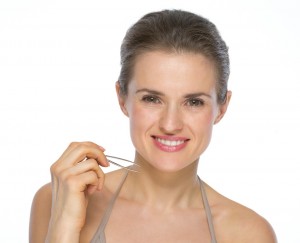 Although it can be an embarrassing subject to talk about, removing facial hair is an important ongoing battle in the lives of many women; particularly those over the age of 30 or from certain parts of the world. We’d all like to believe that women are naturally smooth and hairless, but in reality many of us go to great lengths to achieve that image.
Although it can be an embarrassing subject to talk about, removing facial hair is an important ongoing battle in the lives of many women; particularly those over the age of 30 or from certain parts of the world. We’d all like to believe that women are naturally smooth and hairless, but in reality many of us go to great lengths to achieve that image.
The hair removal market offers us a number of options. They range from low-cost, safe and immediate but short-lasting, to solutions that are permanent but cost more and that have potential side effects.
Beginning with the easier and simpler procedures,
You can tweeze. Plucking your own hairs offers you the convenience of doing it in your own home, and it’s free, but won’t work for multiple hairs and has the potential to damage your skin and cause unsightly discolouration.
Threading. Having your eyebrows, upper lip or chin threaded is relatively low-cost, and can be effective for even the finest of peachy fuzz. It won’t damage the surrounding skin, but could make your skin red for a few hours afterwards, meaning you won’t want to have any face-to-face meetings directly after the treatment.
Waxing. Waxing lasts for four to six weeks, but the hair has to grow to a certain length to be waxed again. Experts warn that you could actually end up spending more time with hair than without it, waiting for your next wax. Waxing can also damage the skin, or lead to ingrown hairs.
Hair Removal Creams. In this category are the foul-smelling hair removal creams we were introduced to in the eighties. They are applied, left on for a few minutes, and then removed, taking the hair with them. They dissolve the hair completely, meaning there’s much less chance of spiky regrowth or ingrown hairs, but they are known skin irritants and should only be left on the skin for a minimal amount of time.
Vaniqa®. Though not an actual hair removal cream, Vaniqa slows hair growth. Its active ingredient, eflornithine, penetrates to the base of the hair follicle, affecting the enzyme responsible for growth. It is used on the upper lip and around the chin and is particularly useful for women who suffer from hirsuitism (excessive facial hair). Vaniqa can be used on its own or alongside other treatments such as laser hair removal.
Laser Hair Removal. When practiced correctly by a professional using the latest equipment and with experience of treating the delicate facial area, laser hair removal can be both safe and very effective. Note, however, that the results are better when there is more contrast between the skin tone and hair colour; it works best without a tan, on women with lighter skin and darker hair, but can also have good results on darker skin. The laser treatment can also help even out skin that may be damaged by waxing or other hair removal techniques. Laser hair removal usually requires multiple treatments. Although it is not an instant solution it does have permanent results.
Electrolysis. Electrolysis is a permanent solution, but is generally not recommended for delicate areas such as the upper lip, as the needle used can cause scarring. It is effective for removing hair under the chin and on the rest of the body, but should probably be limited to these areas. Women with skin that is prone to hyperpigmentation and/or scarring are particularly cautioned against electrolysis. As with laser hair removal, it requires multiple sessions to achieve desired results.
Knowing the options and some of their potential benefits and downfalls can help you make an informed decision when it comes to removing your facial hair, or helping prevent new growth. The best information, however, will come from your doctor. A professional skin consultation can provide you with valuable information regarding your skin type and which treatments will be safe and effective for you.